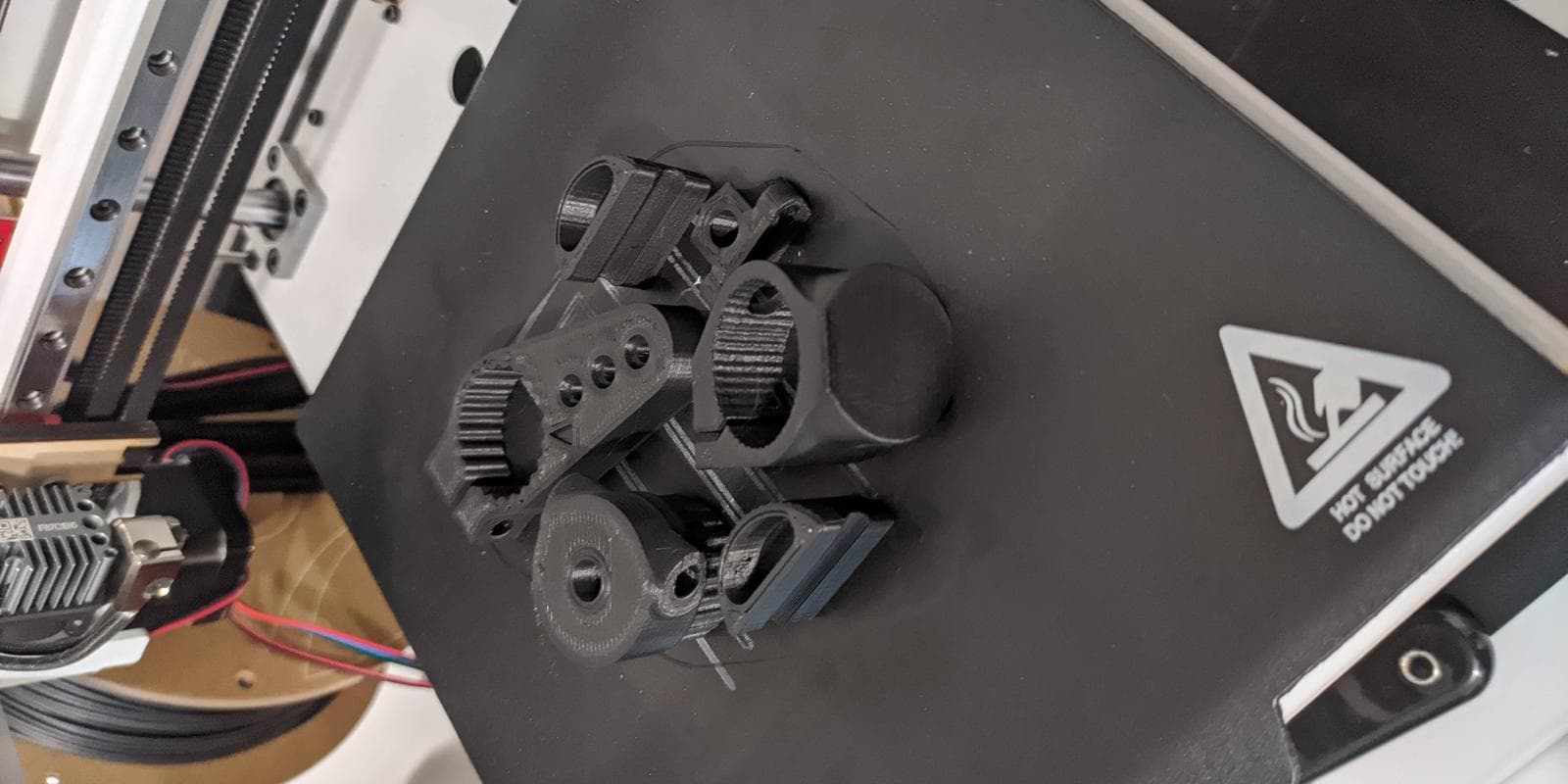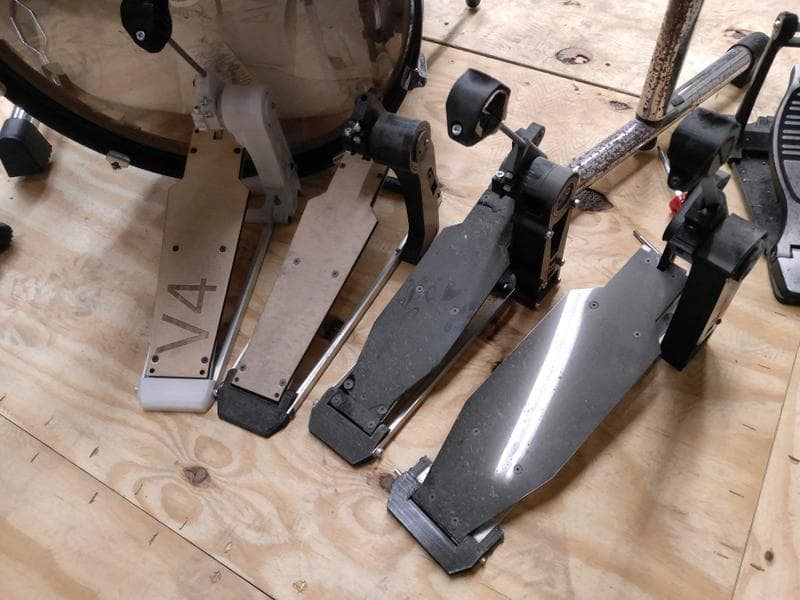Open Source Drum Pedal project
Files are available through this GitHub repository.
Discuss on this Discord Channel to share ideas and progress about these projects.
Open Source Drum Pedal V5
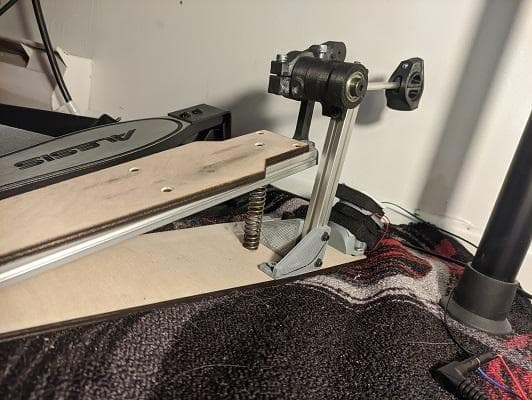
As mentioned in the previous version, a complete redesign was needed. I was struggling with the space required for the spring without compromising the rigidity of the vertical frame. I decided to go in a complete different approach, inspired by the Cobra Coil.
This new design has greatly reduced the complexity of the pedal, in terms of mechanics. However, many adjustments are now impossible, such as:
- Spring tension
- Board height
Actually, these two could be adjusted, but one would require to physically modify parts to make adjustments. For example, a more rigid spring could be used to increase stiffness. This same spring could be slightly shortened to adjust the board height.
Adding more spring positions on the board and base could also be a solution, however both the feel and the board height would be affected by a single change of position. By moving the spring closer to the heel hinge, one's would feel like the spring is less stiff, as the position act as a lever seen by the feet.
I'll go in more details about the changes below, but I'm somewhat impressed by the feel of this design!
Concept details
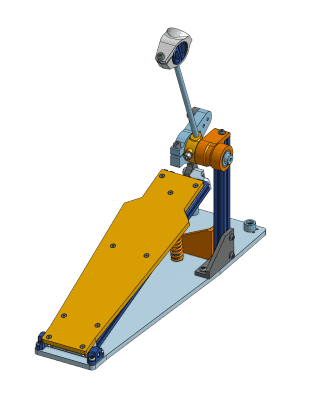
No more aluminum 90° angle extrusion
As I mentioned before, the 90° angle extrusion took me quite a while to prepare for a pedal and I needed a press drill to do it. I had to measure, drill, tap, and ream holes.
It took me a while to find an alternative, as I was constrained in space. I think the heel is already reaching a height limit, thus I ended up choosing 15 mm x 15 mm T-Slot Aluminum Extrusions from Misumi. These are the same extrusion used in the increasingly popular 3D printer called the Voron.
If you recall, I had bending problems using a 1/2"(12.7 mm) 90° angle extrusion when it was 1/16"(1.6 mm) thick. Since the force, material and length are the same for each pedal, I don't need to go into much complicated formulas to compare the bending resistance, only the area moment of inertia can be used.
The equivalent area moment of inertia was 1100 mm^4. When I switched to angle bracket twice as thick (1/8" - 3.2 mm), the new moment of inertia increased to 2270 mm^4. This value has proven to be reliable. With the two 15x15 extrusions, the new value is 2800 mm^4, which is even safer. To give you an idea, a 1/4" (6.35 mm) plate 62 mm wide (equivalent to the shortest width of the board) is 1323 mm^4.
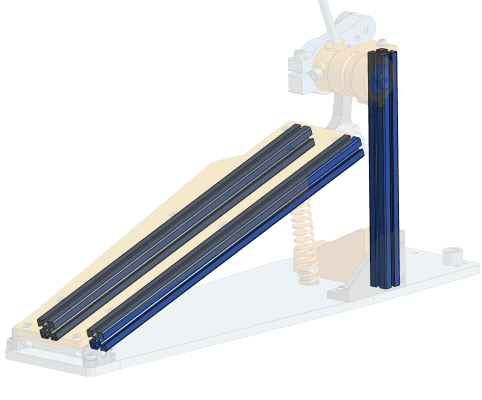
Baseplate design
I also wanted to reduce the amount of extrusions needed for the pedal. I found that by not having a strong baseplate, I had to compensate for the weak vertical frame by adding a lot of strengtheners. This resulted in a lot of plastic printed, and I still had bending issues from the vertical frame.
I also realized that this baseplate design could easily be converted to sheet metal, eventually. I'm still experiencing with ideas, and I want to keep the cost down and the ease of fabrication for anyone to make one themselves, so the wood will probably be there for a while.
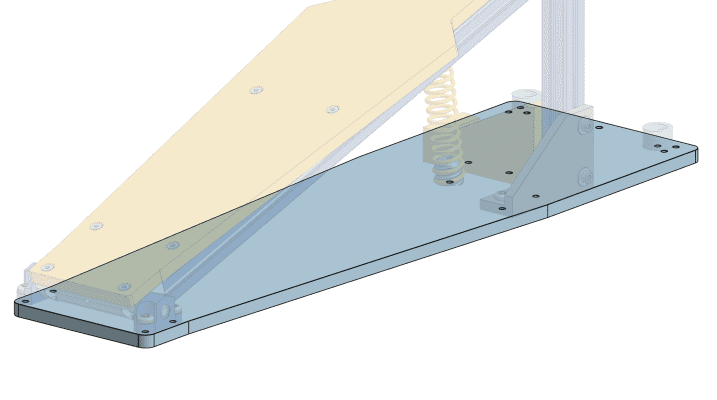
Right now, I hoped to use the wood with wood screw / plastic screw as it would be quite easy. By doing so, I wouldn't have to thread every single plastic insert. Sadly, I couldn't get the right screw due to anti-dumping duty between Canada and USA. I tried to get some equivalent from the hardware store, but it was far from ideal...
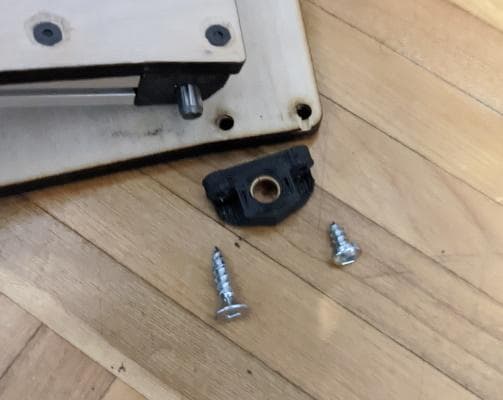
Aluminum vertical frame
Time to print and plastic usage has been a challenge since the beginning of this project. By using the same extrusions as for the board, I wanted to improve these points. The support brackets are now much smaller, and also efficient. I've seen a drastic improvement in bending when applying pressure on the pedal board.
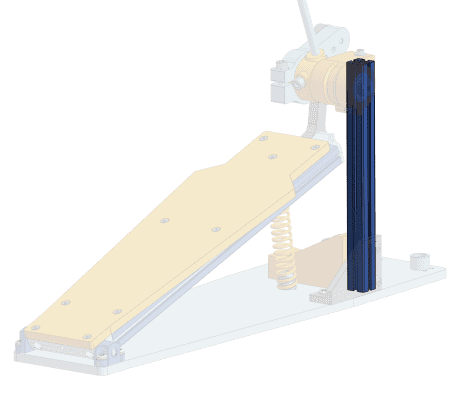
New bearings and axis
I've been using 61806 bearings (30 mm x 42 mm x 7 mm, also called 6806) since the first version. I initially wanted to benefit from the larger diameter to use 3D printing for the shaft and integrate components such as the spring. As the design evolved, I realized it was quite a challenge to keep a certain rigidity, ease of printing and features all together. Also, I felt like the lack of overall rigidity resulted in poor bearing performance, where friction could be felt in the main axis.
I decided to opt for a very simple design, using a shoulder screw as the main axis, and two very common 608 bearing, used in skating and rollerblade.
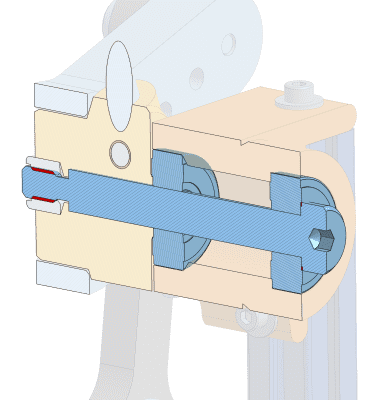
New heel hinge design
This pillow block's style design is simple yet effective. The perfect alignment with the shaft can be fine-tuned during the assembly, rather than relying on proper 3D printer settings or post-machining steps, like reaming.
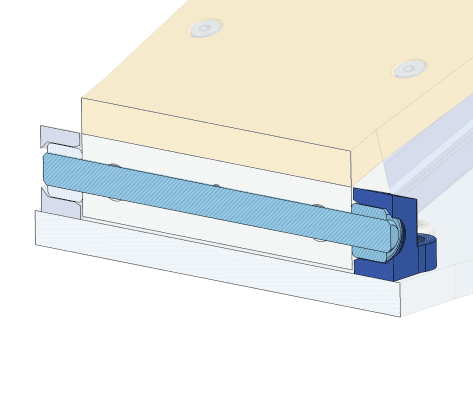
Conclusion
To be honest, I didn't know what to expect from this idea. There has been so many changes since the previous iteration that I would consider it as a new one.
I think the main weakness is very hard to justify, which is the lack of adjustments. A musical instrument is very personal, and I don't believe that taking the path of having "a single version" to rule them all is right. The spring tension is especially something that should be required.
Something else that bothers me is the new kinematics involved in changing the spring attachment. By having it on the board, it's not directly attached to the beater. Every time the beater switch direction, the slack in the bearings also switch, and the feel is greatly affected. You can feel this slack as soon as you put your feet on the board. This problem will get worse with normal wear, which is also a problem. It can be quite a challenge to design something without any mechanical play for a rotating element, especially in such small size. Taper bearing, conical springs disc and other elements could be a start, but this isn't the path I wish to continue for this open source drum pedal.
